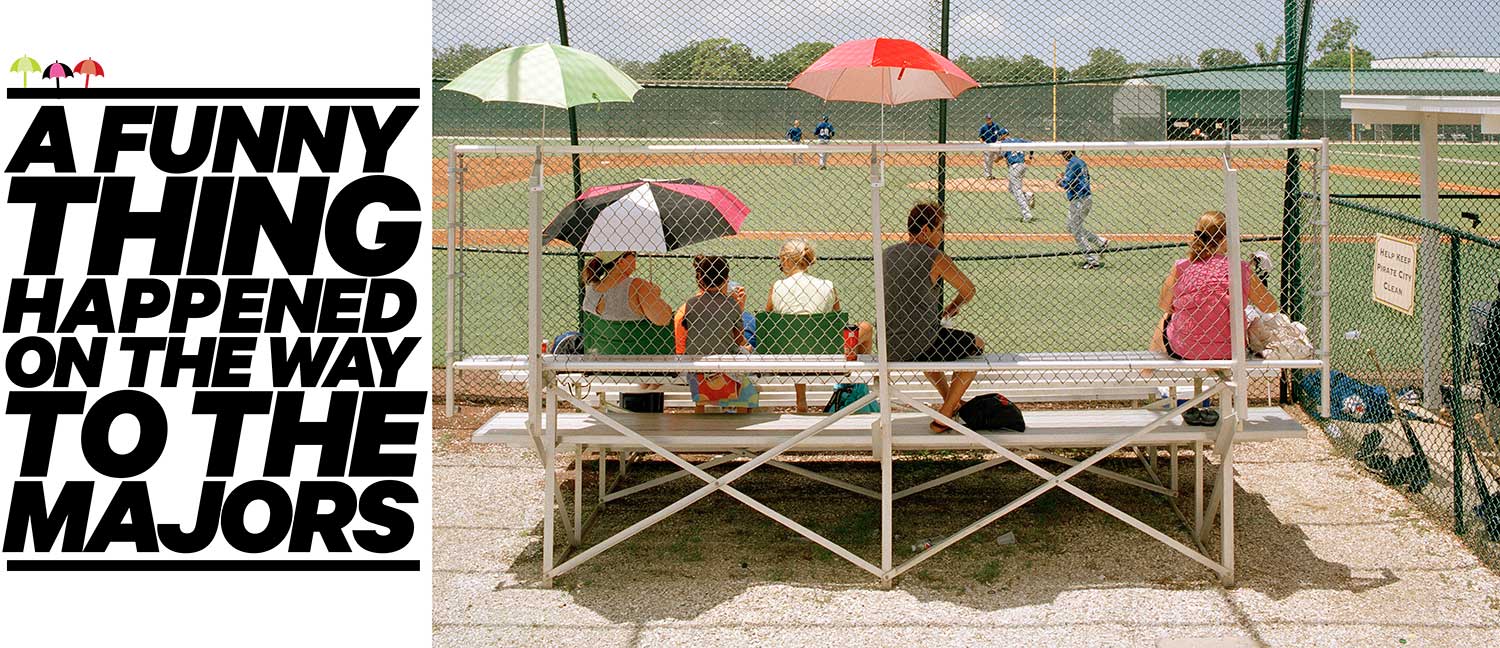
Why the Gulf Coast League is the last place a big-league hopeful wants to be.
By Gare Joyce in Dunedin, Fla. | Photographs by Eamon Mac Mahon

Thomas Collins III stands out in left field, the position he has manned most days since mid-June, which represents his entire professional career. Sweat has drenched his uni. He keeps his head down between pitches, better to shade a face burnt so often that it’s sunscreen-resistant. The pitcher wheels and a sinking line drive is hit in Collins’s general direction. He gets a great break on it, dives, digs it two inches off the grass and slides face down, holding his glove aloft in view of the umpire. In other parks, fans would roar, but here the silence is broken only by a single exhausted voice in the dugout saying “Boom” and a car alarm going off in the distance.
The score explains the muted enthusiasm. When Collins, a.k.a. “Boomer,” trots off the field, his GCL Blue Jays trail the visiting Yankees 6–0 on field No. 2 at the Bobby Mattick Training Center in Dunedin, Fla., and it’s only the bottom of the sixth.
Collins knew it was going to be a bad day when the snakes beat him to the dugout that morning. Okay, it’s the first week of August, and by now he and his teammates have become inured to the daily discomforts: the 5:30 a.m. wake-up call; two and a half hours of practice in the field under the intensifying Florida sun; the miles of wind sprints run and tonnes lifted in the gym; the temperature escalating to 99 degrees; and yet another game starting at noon with their team sitting in last place. When their first professional contracts were pushed in front of them, they might have been forewarned about what they were signing up for. No one had told them about snakes, though. They had to wonder what other fauna lay out in the swamp and bush between the outfield fence and the trailer park. For the record: No game in the Gulf Coast League has ever been called on account of gators. Yet.
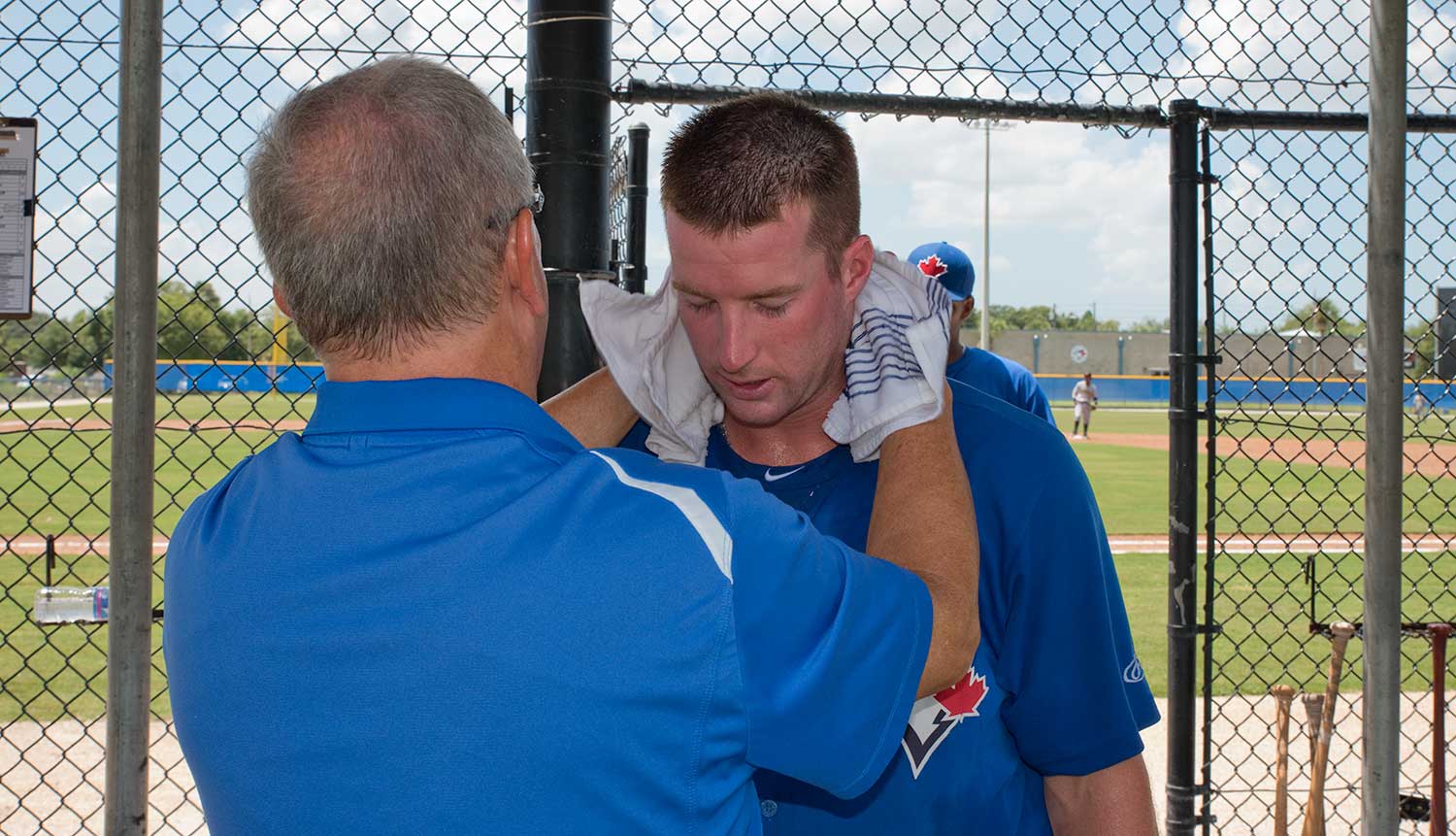
Not in the GCL: Jumbotrons, scoreboards, official attendance figures, spectators, souvenirs, concessions, managers arguing with umpires, national anthems, announcers, radio, TV, wind, more than five metres of foul territory, visitors’ locker rooms, working water fountains.
When we think of the minor leagues, we think of Bull Durham, a movie from 1988 that evoked a romantic idyll of the game. Seen through Hollywood’s gauze and soft focus, the minors were populated by young men in love with baseball, their hearts not yet broken, their innocence not yet overtaken by the business of it all. Kevin Costner’s Crash Davis was their switch-hitting Gandalf, a catcher who, alone among them, knew all about the game’s cruelty and appreciated the irony of the all-knowing veteran donning the tools of ignorance.
Though a pure Hollywood confection, Bull Durham got a lot of things right, foremost among them the fact that the minors don’t always look like a pure Darwinian struggle or meritocracy to those standing in the dugout. That was true of the fictional Bulls and is even more so for the real-life minor-leaguers, especially those in the GCL.
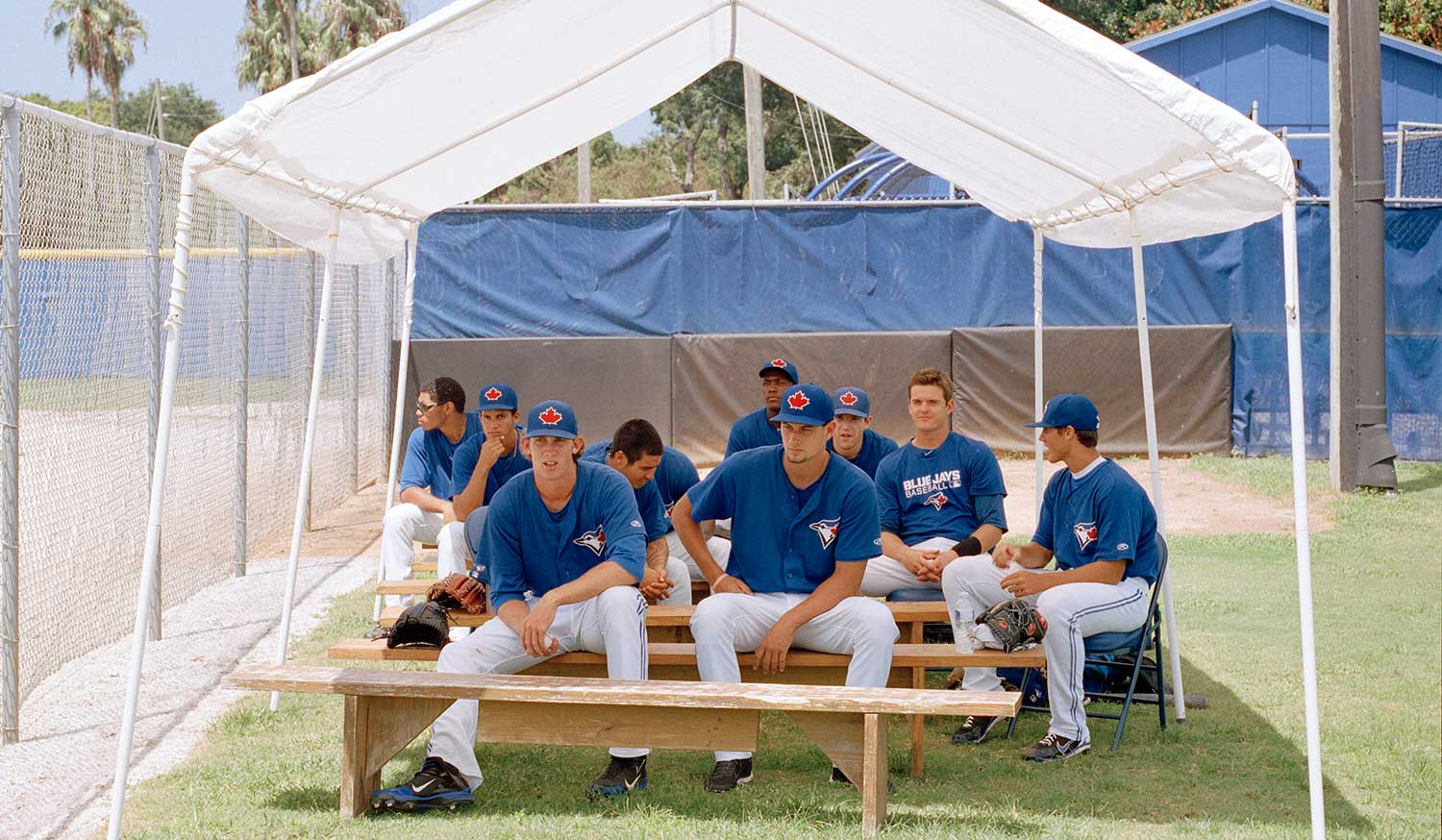
The GCL represents baseball’s entry level, one of four Rookie leagues, and it dates back to 1964 when it occurred to MLB teams that they could develop raw meat in a controlled environment with minimal costs at spring-training facilities in Florida over the summer. For more than 20 years, several teams set up camp at Pittsburgh’s multi-diamond complex, Pirate City, a remote piece of reclaimed swamp east of Bradenton, and players lived in almost inhumane conditions. The Jays had teams in the GCL for five years in the early ’80s and five more in the early ’90s, but for long stretches they opted to go with rookie outfits in more conventional settings in the Pioneer League out west and the Appalachian League in the east. In the intervening years, though, the other clubs with GCL teams upgraded their facilities and moved their teams from the Spartan bunkhouses at Pirate City into cheap out-of-season motels, and Toronto management opted to rejoin the league in 2007.
These improvements in living conditions notwithstanding, those who’ve been through it will attest to their seasons there being the longest of their lives. The GCL goes by various nicknames, some publishable; most popular among them is “the Gulf Roast League,” a tribute to the cloudless swelter of south Florida summer and a schedule of 60 midday games in just over 11 weeks. “The first little while you might see guys cramping, dehydrated, but they realize they have to stay hydrated,” GCL Blue Jays manager John Schneider says.
Demographically, the GCL resembles minor leagues in any sport. Just about every kid who reports has been the best on every team he’s ever played for and must finally confront the fact that other guys can play, too. Nowhere, though, is the message driven home so ruthlessly as in the GCL. Both body and spirit are exhausted, and there’s no journeyman named Crash to impart life wisdom, because the GCL limits players to a maximum of two seasons. Some kids are savvy, some naïf or even oblivious, but each will have to figure out on his own whether he’s heading up or heading out.
In the GCL: whooping cranes in the outfield, swarms of condor-sized dragonflies, one bathroom per field (door optional), wood bats, players not in the lineup working as bat boys and manning the radar gun behind the screen.
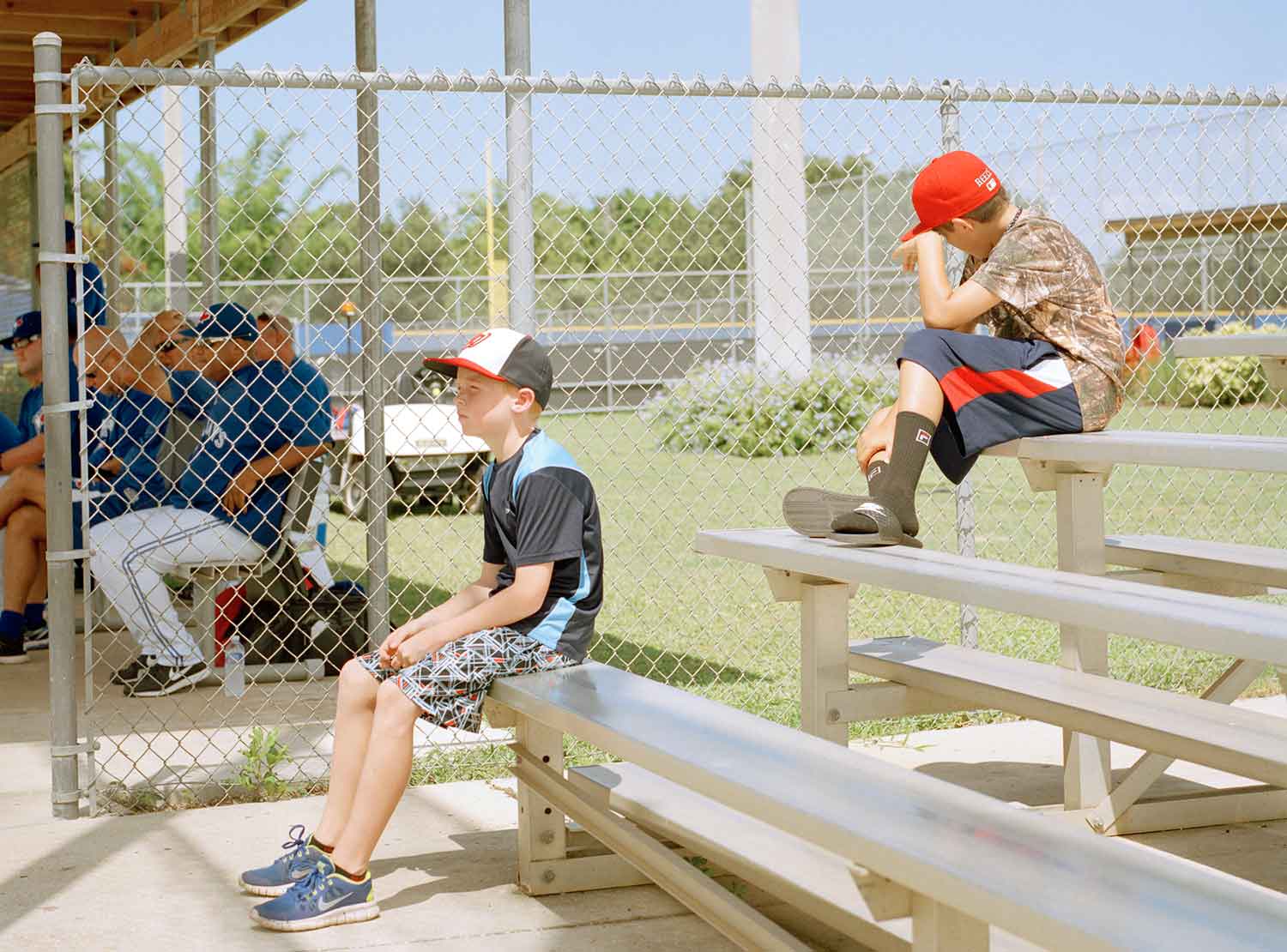
The game against the Yankees is six hours away when Boomer Collins beats his teammates into the lobby for the cold-breakfast buffet, the most value he sees out of the rundown motel for which his paycheck is docked $15 a night. Every day, he gets his Frosted Flakes, sits down at a table alone and bows his head in prayer. This morning it’s raining, and a loud clap of subtropical thunder echoes through the lobby, like it did the moment he was born, prompting the attending physician to tell his proud parents, “You have a real boomer here.” Collins checks a newspaper to see if there’s any chance for a rainout. There isn’t. One prayer unanswered.
“I like this quiet time,” he says in a voice barely loud enough to be heard over the rain and traffic on Highway 19. “I want to be wide awake getting to the complex.”
Collins has rolled out of bed before sunrise for 10 weeks and tries to keep a bright outlook every waking hour. “The season’s been great,” he says. Accomplishments: He leads the team in hits and batting average. Souvenirs: He has an Instagram of him standing beside Derek Jeter, who was on a rehab assignment. Pilgrimage: The team gave him a ticket to see Toronto’s big club play the Rays at the Trop in St. Pete. Memory: He hit his only two homers the day his parents made it to Florida to see him play as a pro for the first time. Each highlight gives him positive reinforcement.
Collins needs them, because he’s 24. Birthdate: June 13, 1989.
Mike Trout just turned 22. Aug. 7, 1991. Yasiel Puig is 22, too. Dec. 7, 1990.
The cold fact in the swelter is that Collins is old to be a prospect. Eventually, the baseball men in the organization will regard him as too old to be a prospect. That could be any time, as soon as tomorrow.
At 18, back in Waxahachie, Texas, his future in sports looked bright: all-state honours as both an outfielder and a quarterback, baseball and football scholarship offers from dozens of schools in the southwest. After posting a .522 batting average as a senior, he decided to focus on the diamond, accepting a ride to Nebraska.
Life in college didn’t unfold as neatly as it had in Waxahachie. He hit .245 as a freshman, .215 as a sophomore. Needing a reboot, Collins transferred to Dallas Baptist, a smaller program but one with a schedule loaded with big-name schools. It meant sitting out a year before becoming eligible to play. Back then it seemed like he had the luxury of time.
The decision paid immediate dividends: Collins had a huge junior year, with a .374 batting average and 13 homers in 60 games. Boomer was a late bloomer, it seemed. Major-league scouts let him know that he was looking at a selection in the first 15 rounds of the June draft, and he let them know what his price point would be. On the day of the draft, he sat with his family and waited for the phone to ring.
It didn’t.
“Might have priced myself too high and scared off teams,” he says. “Overplaying my hand.”
It looked that way this spring. His numbers plunged in his senior year: a .271 batting average, seven homers. Again he went undrafted, but this time the phone rang: Mike Wagner, a Blue Jays scout in Texas, called with a free-agent offer. No bonus. “I accepted before he got the words out,” Collins says. “I thought, ‘I’ll play better and make them promote me.’”
He has squeezed everything out of his game here, but consummate effort can’t erase thoughts about roads not taken. “My father and I went to an Army-Navy game, made me want to go to Annapolis,” he says. “I could have run their option offence. And I could have become a fighter pilot.”
This glory-filled reverie is interrupted by other motel guests—four rough-looking members of road crews, their work clothes covered in yesterday’s dust, grab doughnuts from the buffet. Collins looks at them sympathetically, but in one way, his sympathy’s misplaced: The $200 he clears for a 60-hour week is just about the daily wage of the guy in the orange vest who’ll spend eight hours holding a stop sign on the interstate.
Number of players on the 2007 GCL Blue Jays roster: 39. Number of undrafted free agents on that team: 12. Number of UFAs on that team to play in the majors: two (Moises Sierra, Joel Carreno).
The rain has stopped when Boomer Collins’s roommate, Corey Gorman, arrives at the Jays complex. His index finger dances across his iPhone’s screen. His random Twitter entries provide insight into the 23-year-old:
“It’s a grind haha but beats having to work in the real world haha.”
“Pee tests are awkward. Don’t watch me pee old man #imnotonsteroids.”
“I’m talkin about a place where the beer flows like wine. Where women instinctively flock like the salmon of Capistrano.”
Though you wouldn’t know it from these deep thoughts and an unvarying expression of boredom, Gorman will walk up on stage at the University of Scranton this fall and collect his M.B.A. He’s Dumb and Dumbering down to fit in with his teammates. In fact, Gorman gave up a job to sign a minor-league contract with the Jays in June. “I just started a job as a credit analyst at a bank,” he says. “I hoped that I’d get drafted. Disappointed when I didn’t, but I was pitching at Scranton, a Div. III school. I wasn’t recruited out of high school, didn’t even go out for the team as a freshman.”
The night the draft wrapped up, Gorman got a call from a Blue Jays scout. “I can’t remember his name, but he got fired,” Gorman says. The soon-to-be-job-hunter offered Gorman a free-agent contract to come down to the GCL. The scout had no bonus to offer and gave Gorman until the end of the phone call to make his decision. “I had to take it,” Gorman said. “I couldn’t be asking myself, ‘What if?’ the rest of my life.”
Gorman couldn’t put the real world on hold while pursuing his dream. Looking to be a chartered accountant down the line, he can itemize his liabilities by memory and to the penny. “Twenty thousand in school loans every year for five years, car payments and insurance, and my car’s parked back at my parents’ in Scranton,” he says. “I barely cover the interest. In two years, I might have to give up the game and work to pay my way out of debt.”
To say Gorman arrived in Dunedin illusion-free is thus an understatement. He sees the GCL as a teaching institution that doesn’t award marks, just a system where those in the class get honours, a pass or an F.
Honours get you out of the GCL. “The only way to get promoted in the middle of the season is to prove you’re too good for the league,” Gorman says.
Only a couple of top prospects can hope to be fast-tracked. The priority for all the rest is earning a passing grade—winning an invitation back to minor-league training camp the following March. The only guarantee of that comes when they’re designated for the instructional league at the end of the GCL season. “That’s what you’re playing for,” Gorman says. “That tells you you’re in the plans. If you get invited to the instructional league, then you’ll go to Bluefield [in the high-Rookie Appalachian League] or Vancouver [in the low-A Northwest League] next season. If you’re not invited, you don’t know.”
Gorman thinks he should be invited. He’s trending upwards. He has worked his way up from the bullpen to the top of the rotation. His ERA is under 2.00. “Could be better; last game a couple of runs came in on ground balls that guys in single-A make plays on,” he says. Even if he tails off a bit, Gorman feels like he’s on track for a pass, like he should have no worry about a grade of F and imminent release.
Though he can see life play out on an Excel spreadsheet, Gorman’s ambitions are quixotic. “Nobody came out to our games in Scranton, you know, Div. III,” he says. “I’d like to play just once in front of a crowd.”
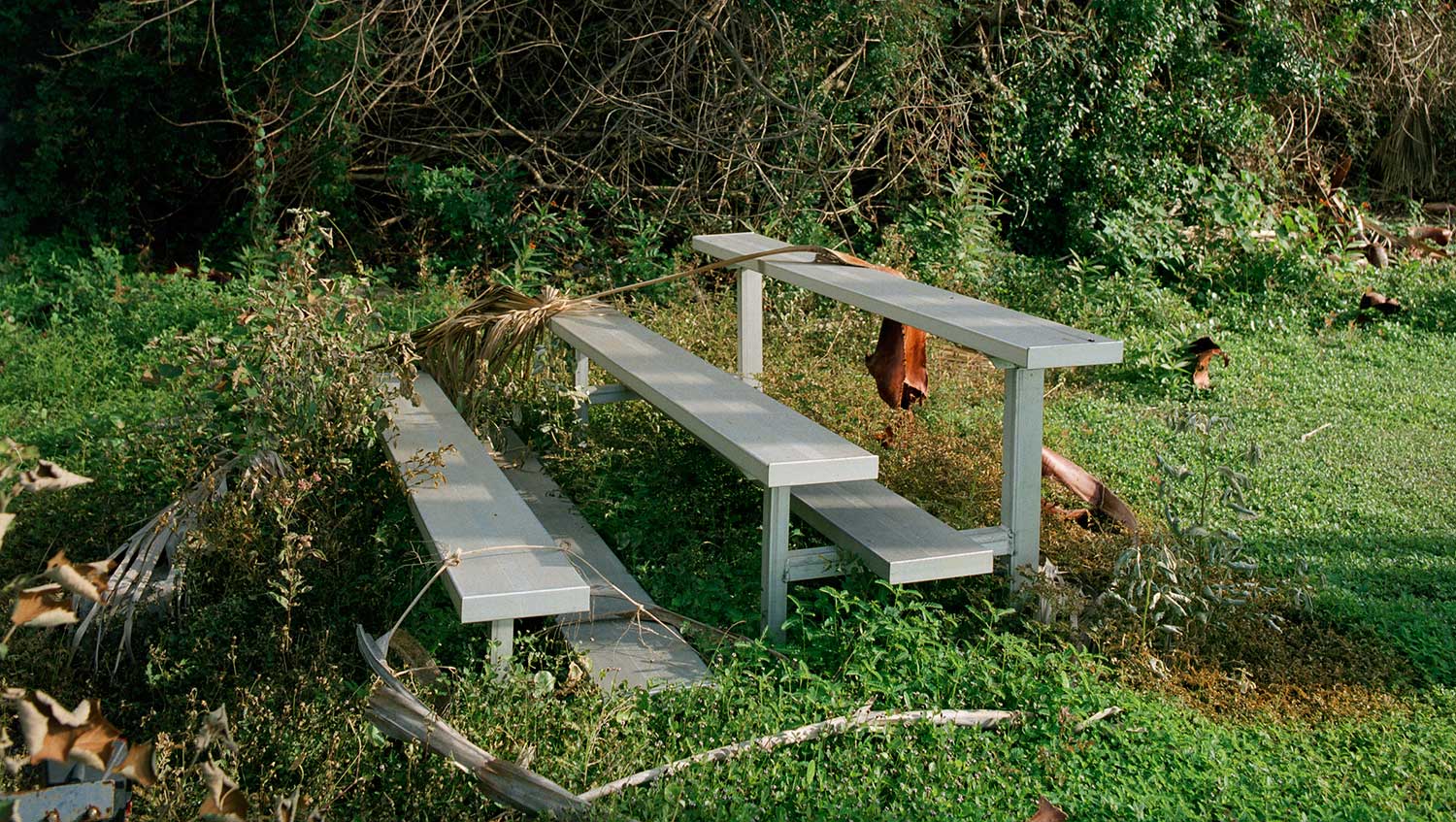
Sex in the GCL, according to Corey Gorman: “There are no groupies. If you told a girl around here you’re in the GCL, she’d laugh in your face.”
The words are scrawled on the dry-erase board: “soap, shampoo, deodorant, razor, shaving cream, comb, brush.” The Jays are trying to groom Franklin Barreto into a major-leaguer, but he’ll need some work to be able to groom himself away from the yard. Signs reading “Se habla espanol” won’t be hanging in drugstore windows in Vancouver or Bluefield, West Virginia, or other links in the chain. Or Toronto, for that matter.
Barreto sits with five Latino teammates in a conference room overlooking field No. 2, where he’ll play at noon. With his notebook open, he looks like a schoolboy—no stretch, as he’s 17 and won’t need a razor or shaving cream for another season or two.
At times in the GCL, it seems like English is the second language. The GCL Jays feature 14 Latin American players on its 35-man roster, and that’s a low number in the loop. The GCL Nationals are carrying 21 Latin American players this season and will go 49-9 for an .845 winning percentage, a pro-baseball record.
Though he looks fairly average sitting in his uniform in the ESL class, Barreto is anything but on the diamond. “Power to all fields, best prospect in the league,” Gorman says. He’s also among the richest. Stories about major-league teams landing elite Latino kids for a bag of beans are the stuff of lore. Barreto tore up tournaments with the Venezuelan national junior team before signing with the Jays last year for $1.5 million. Asked how many teams tried to sign him, Barreto doesn’t estimate. “Treinta,” he says. All 30.
Hype and bonuses notwithstanding, no Rookie-league prospect is guaranteed to land in the majors. Some veteran baseball men question Barreto’s upside. “He has real good bat speed, but he’s five-foot-nine, a buck seventy,” a coach of a rival GCL team says. “He’s not growing, so his power numbers [in the majors] aren’t gonna be special. And his glove is suspect [at short]. Does he wind up at second? Centre? Maybe. But he’s not really a five-tool kid.”
Of course, in that skeptical coach’s minor-league career he’s made less than Barreto’s net worth before Barreto played one game in the GCL. If Barreto doesn’t know how to ask a drugstore clerk for a nail file, he can afford to go to the spa.
Miguel Cabrera’s GCL career: 57 games, 219 at-bats, two HR, 22 RBI, .260.
Joey Votto’s GCL career: 50 games, 175 at-bats, nine HR, 33 RBI, .269.
Mariano Rivera’s GCL career: 22 games, 52 innings, five wins, one loss, ERA 0.17.
Paul Elliott sits on a stool behind a net and lobs balls by the bucket to Boomer Collins at a distance of 10 feet or so in the shaded batting cage. A tall, ruddy-faced Australian with a gruff, taciturn manner de rigueur for baseball men irrespective of nation of origin, Elliott will do this for 90 minutes or as long as it takes to work through the roster. In his 18th year in the organization, he’ll do this with a metronomic repetition that is grim yet perversely hopeful, like a guy feeding rolls of quarters to a slot machine parked under a neon sign promising a million-dollar payout. Likewise does Collins take his hacks, hoping that another bucket of balls and another callous will fine-tune a swing so that it might reap him one extra flare a week, a ground ball with eyes, one more dying quail that will get him to instructional league.
It seems like a fool’s errand for Collins, and no less so for those hitting off tees or standing in against a pitching machine.
A mellow, bemused giant along the lines of a young John Goodman, John Schneider leans against a wall off to the side of the netting. Schneider knows about baseball life as it’s lived everywhere except the majors. He has stood in Boomer’s spot, sat in Elliott’s and lived in fear of the skip he ended up becoming. If you ever questioned his love of the game, you wouldn’t after listening to him rhapsodize about the one time he caught Roy Halladay in a workout—diamond nirvana delivered in 35 pitches. A baseball lifer only now approaching mid-life, Schneider was a 13th-round pick of the Jays back in 2002 out of the University of Delaware and batted below the Mendoza Line in double-A and triple-A in 2007, a season when he had three concussions and back surgery. He went to training camp the next season as a 28-year-old catcher and left it as a young coach. Now he manages a club that’s younger than most college squads.
Schneider tries to stay philosophical about his team. “It’s a teaching league, and high-schoolers, 18-year-olds, need more teaching than the college boys,” he says. “We’ve gone younger than most teams down here the past few years. Those kids are playing more than they ever have before. They’re using wood bats when they’ve been using aluminum before. You adjust your expectations. The college guys, they’re on a shorter leash.”
When Collins steps back to adjust his gloves, he peeks over at Schneider. On a short leash that strangles other undrafted free agents, he knows his future might hinge on the manager’s say-so. Schneider says he doesn’t let it weigh on him. “You try not to get too attached to the kids,” he says.
Bonus paid by Boston to 18th-round draft pick in 2012, outfielder Shaq Green-Thompson: $45,000. Green-Thompson’s 2012 GCL stats: 39 at-bats, 37 strikeouts, no hits, one RBI.
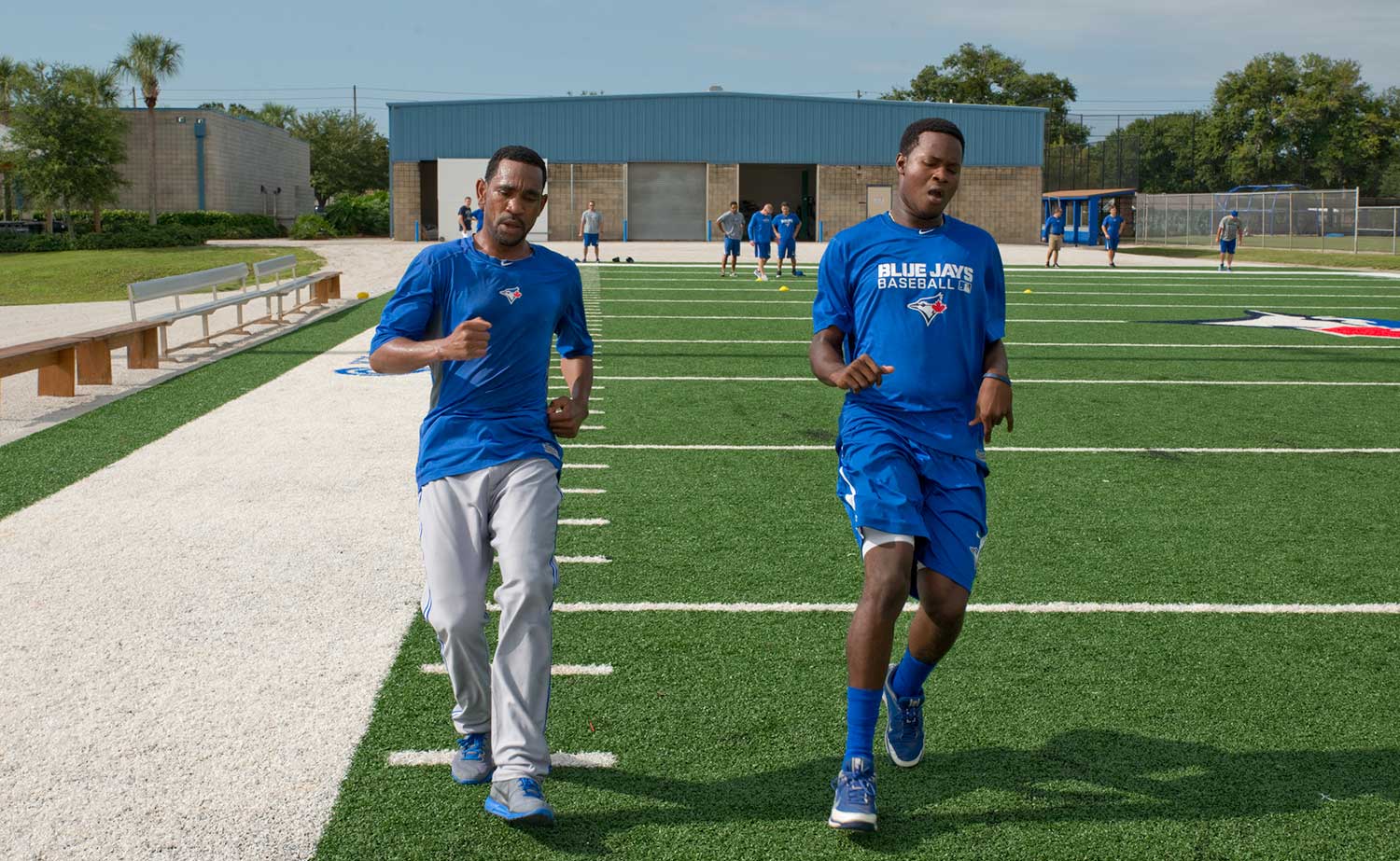
By the ninth inning against the GCL Yankees, the outcome isn’t in doubt, and Schneider pulls both Collins and Barreto. The former was hitless in three at-bats with two Ks, while the latter had nervous moments at short and was lucky to avoid a couple of errors. At game’s end, Collins and Barreto are among the last to come into the clubhouse. Schneider waves Barreto into his office. The youngest player on the team looks apprehensive, like he’s being hauled out of class to see the principal. Schneider sits at his desk and Barreto stands. He’s ready for the message that the organization wants to try him at second or maybe in centre field. Schneider doesn’t mince words. “You’re going to Bluefield,” he says.
Barreto doesn’t wait for the translation before breaking into a smile. Bluefield never came up in English class, he couldn’t find it on a map, but he knows what it means. Fuga. Escape. He’s given details about his flight and doesn’t hear a word of it. Bluefield is bound for the playoffs, but he doesn’t know it and it wouldn’t matter.
The conversation is brief. It’s also rare. “No one explains anything to you down here,” Gorman says. “I was in relief the first few weeks and then I looked up on the board and I’m down for a start. I was told I was going to throw changeups. I never threw changes my whole life. I had to learn a new pitch and use it against better batters than I ever saw. Last game, I threw 20 of 24 for strikes. You have to trust that they know better than you.”
Gorman would like to know where he stands in the big picture, but it takes two people to have that dialogue, and it’s just not the rookie’s place to ask questions.
Travel in the GCL, according to Collins: “We’re on the bus in uniform for road games. Worst is afterward. You sweat in the sun all game and then you have to get on a bus where the driver has the AC running. Two- or three-hour ride back from Kissimmee after a Braves game is like going from a sauna into a meat locker.”
The Jays will invite 10 players, maybe a dozen tops, to instructional league. Collins seems confident he’ll be among them. It’s not just that the GCL Blue Jays are thin in the outfield. No, his fundamental belief holds that all honest toil will be rewarded. “I think I have a good shot,” he says.
As is his wont, Gorman reduces it to math: 10 spots, maybe 12, to be divided among 35 bodies in the clubhouse and further divided by position, meaning five, maybe six pitchers getting the call. His chances looked good until Jimmy Cordero, a Dominican kid who couldn’t find the strike zone and had an ERA over 10 halfway through the season, suddenly found his compass. “He looks unhittable sometimes,” Gorman says. No exaggeration: Cordero carries an ERA of 0.50 over the past month and once registered six strikeouts in two innings of work. Cordero guaranteed himself a spot with that single performance.
Gorman’s chances took another blow when the team called up a six-foot-five kid named Miguel Castro from the Dominican summer league late in August. At some point, maybe as late as the second 93-mph fastball that he threw in Dunedin, it was clear the 18-year-old had to cancel any plans he had this fall.
Gorman and everyone in the clubhouse takes consolation from the fact that form often doesn’t hold, so numbers shift, right up until the day invitations go out.
Number of players on the 2011 GCL Blue Jays who never made it as high as A-ball: 24.
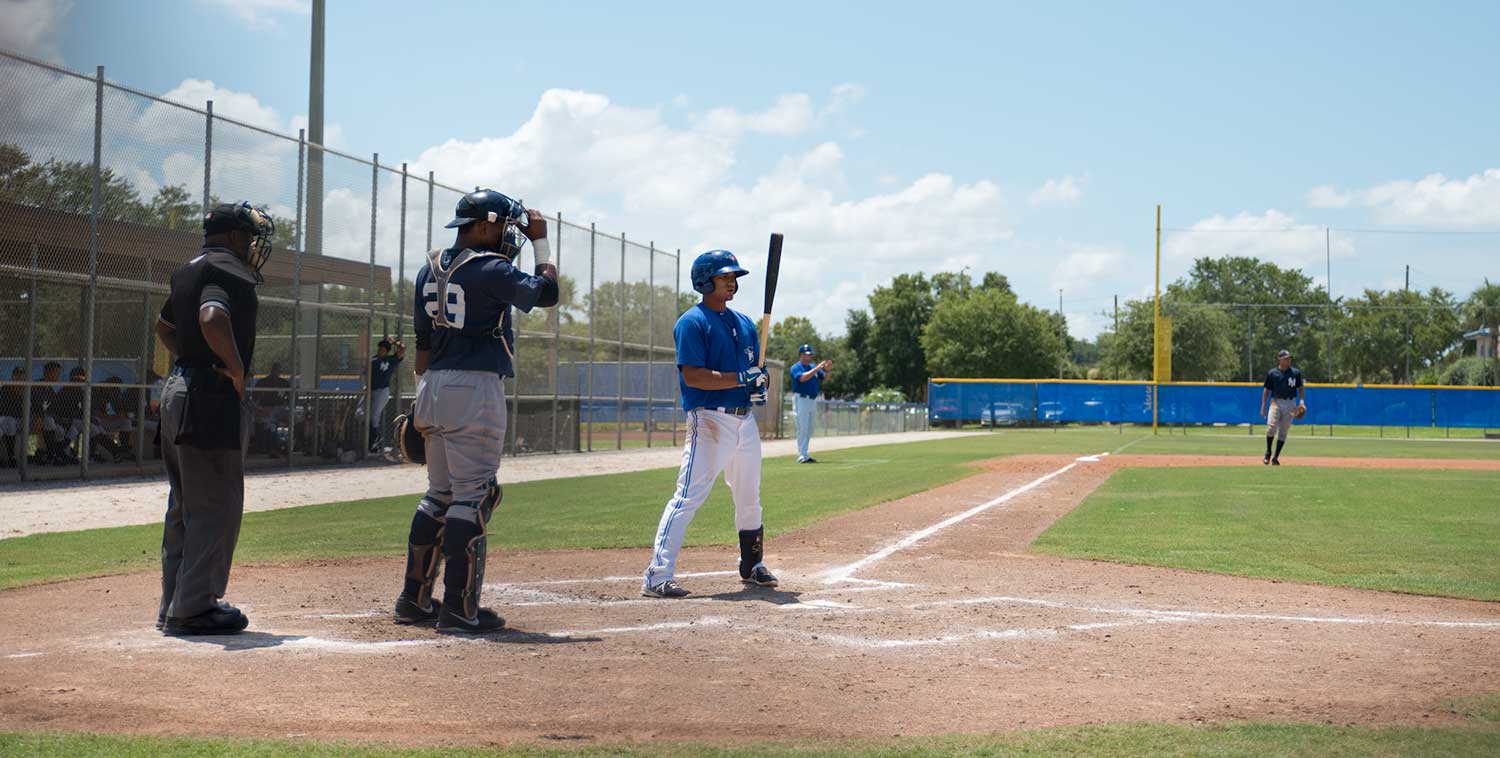
Flash forward to the last week of August. Those in the Toronto office charged with such things have sifted through reports filed daily by the GCL staff. They’ve downloaded and scrutinized hundreds of hours of video. They’ve stared at the organization’s depth chart in search of some grand design. They have made their decisions, and John Schneider is acting on them discreetly, although discretion isn’t something you’d expect to find in the toolbox of minor-league managers, a notoriously brusque lot.
After a loss to the Pirates in the second-last game in Dunedin this summer, Schneider makes the rounds of the clubhouse, pulling aside players at what passes for random. He pulls aside Matt Smoral, a six-foot-eight left-hander who missed all of the GCL season last year with a foot injury and, when blisters didn’t force him to the sidelines, walked a batter per inning this summer. He pulls aside Rowdy Tellez, a tall but pudgy first baseman who spent his first four weeks in Dunedin batting around .100. Grabbing a Spanish-speaking coach, he pulls aside Venezuelan right-hander Jesus Tinoco, who is winless in five decisions.
Collins and Gorman watch it all play out. Hopeful as they were, they feared it would go down like this. The bad news: They’ve played their asses off but aren’t going to instructional league. Those whom Schneider taps can make arrangements to stick around through October.
Though they outplayed the others, Collins and Gorman understand the reasoning. Six-foot-eight left-handers come around only so often, and the Jays had signed Smoral out of an Ohio high school last year for a $2-million bonus, double the projected price of a player taken 50th overall. The Jays are financially obliged to give him special attention. Likewise, Tellez, who pulled down an $850,000 bonus in July, knew he’d be bound for instructional league. As for Tinoco, he is 18 and already six-foot-four. He has a 93-mph fastball and a signing bonus of a quarter-mil.
Collins hides any wounds. Instructional league is “a young player’s thing, not really for college players,” he says. He maintains that not getting tapped won’t weigh on his mind.
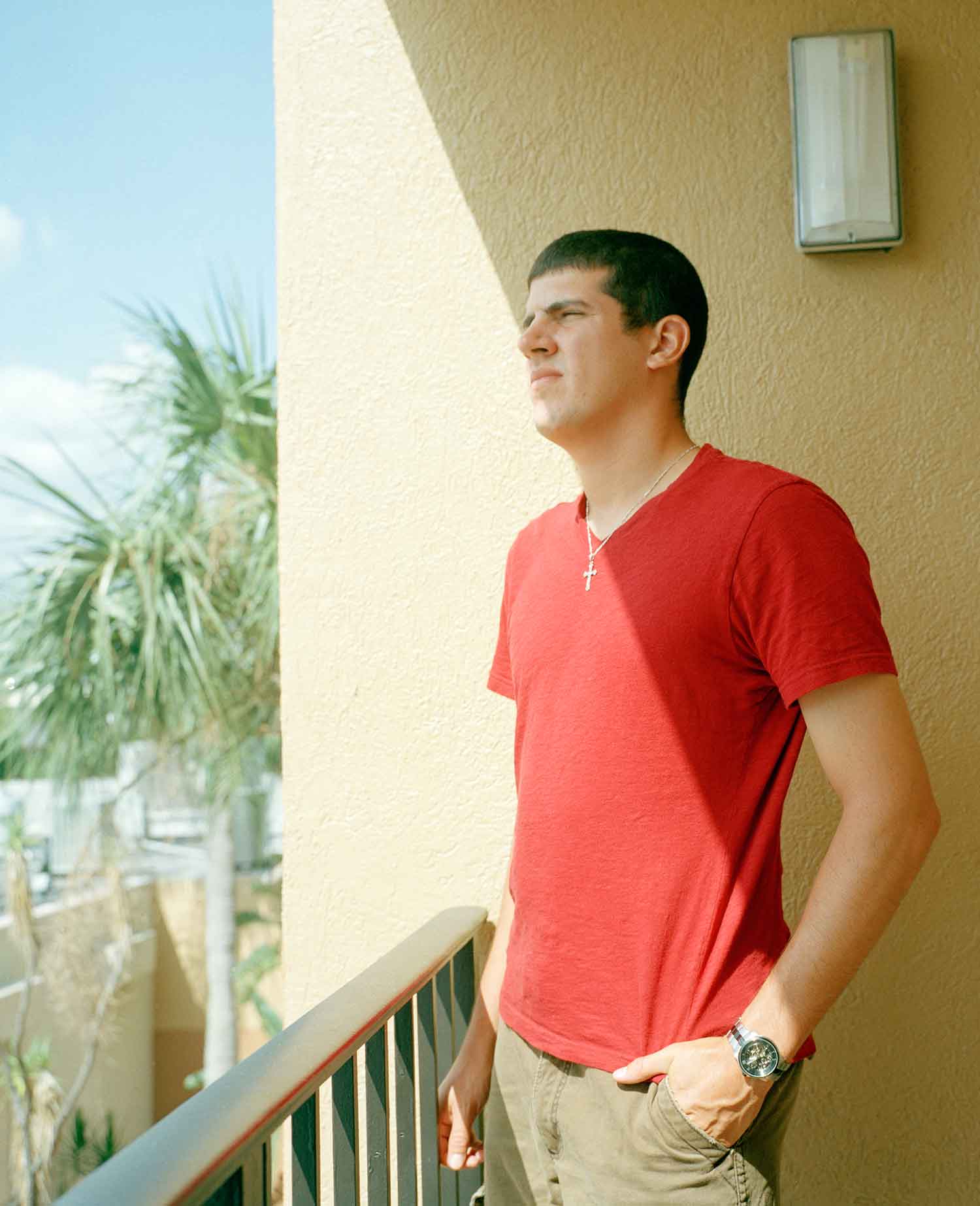
Gorman is less sanguine. “I’m happy with my season, but instructional league would mean something because it’s the organization’s way of telling you they’ve noticed,” he says.
Corey Gorman with his 1.91 ERA and GCL all-star Boomer Collins think they know how it will unfold. In October, Smoral, Tellez, Tinoco, Cordero and Castro will be getting remedial work in Dunedin. Meanwhile, in a week’s time, Gorman will be back in Scranton, grabbing a few beers, catching up with his buddies from college, and Collins will be back in Waxahachie, showing off the Jeter Instagram, catching up with his girlfriend. Gorman will scramble to make a much-needed buck, and Collins will work for a pool-maintenance company. Gorman won’t know if he’ll get a chance to finally play in front of a crowd, and Collins will tell friends that he’s not sure where he’ll be assigned next year. Both will try not to twist themselves into knots about their immediate futures in baseball, and neither will pull it off. The Blue Jays won’t have told them when they should report to spring training. Or if.
That’s why it’s the worst league in the world. Not because it’s an awful beginning, with the long days, the heat, the absence of cheers, the silence, the snakes and the rest. No, it’s the worst because there, in the last week of the GCL season, you first realize that your best might not be good enough. And when you go home, a game goes on without you.
And yet, there is that consolation: that form often doesn’t hold. After the last game of the 2013 GCL season—Blue Jays 8, Yankees 3, on Aug. 29—one last number shifts.
The organization did notice. They just didn’t say anything until something had to be said. John Schneider waits in his office for a player summoned out of the dressing room while he’s clearing out his stall. Ten minutes later, the player tweets: “Well I guess that countdown to coming home was premature. #bluefieldbound #playoffcallup #gobluejays”.
Last game of the Appalachian League playoffs, Sept. 1, 2013: Pulaski 6, Bluefield 4. Franklin Barreto: four at-bats, three hits, three RBI, two errors. Corey Gorman: one IP, no hits, no runs, no earned runs, one BB, 0.00 ERA. Official attendance: 952.




Almost Done!
Please confirm the information below before signing up.
{* #socialRegistrationForm_radio_2 *} {* socialRegistration_firstName *} {* socialRegistration_lastName *} {* socialRegistration_emailAddress *} {* socialRegistration_displayName *} By checking this box, I agree to the terms of service and privacy policy of Rogers Media.